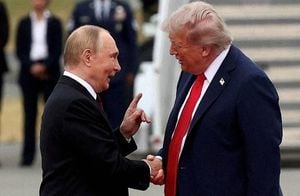The landscape of American industry and global trade is undergoing seismic shifts in 2025, as President Donald Trump’s sweeping tariff regime reshapes everything from clean energy to international investment strategies. While the administration’s protectionist policies aim to revive domestic manufacturing and assert American economic dominance, the actual results are far more complicated—and, for some sectors, deeply troubling.
On August 28, 2025, multiple reports converged to paint a nuanced picture of the effects of Trump’s tariffs. According to The National Interest, the centerpiece of the administration’s latest strategy is a 10% baseline tariff on all imports, buttressed by 57 targeted duties. These include steep levies on critical materials like lithium-ion batteries and copper—essential ingredients for the clean energy transition. The intention is clear: bring manufacturing back home, reduce reliance on China, and, perhaps most importantly for Trump’s political base, signal a return to "America First."
But as Henry Sanderson, author and clean energy journalist, observes, the reality diverges sharply from the rhetoric. "Tariffs alone cannot build a clean energy sector in the United States," he writes. "Without parallel investments to expand supply chains, sustain demand, and train a skilled workforce, the United States is risking ending up with higher costs, slower growth, and continued dependence on foreign producers." Sanderson’s analysis, echoed by industry data, reveals that the protective wall of tariffs has created a market with few real winners.
Take the battery sector, for example—the backbone of electric vehicles (EVs) and grid storage. On paper, tariffs on Chinese lithium-ion batteries and critical minerals, such as a staggering 93% tariff on Chinese graphite imports, should give U.S.-based producers a leg up. In practice, however, only a handful of firms can operate at the necessary scale. Korea’s LG Energy Solution, the world’s largest battery maker outside China, recently inked a $4.3 billion deal to supply Tesla. Yet even LG, with all its resources and experience, saw its U.S. battery plants running at just 51.3% capacity in the first half of 2025.
Meanwhile, American startups are finding it nearly impossible to compete. The protected market is stifling growth rather than spurring it. And despite the tariffs, the U.S. imported $6 billion worth of Chinese lithium-ion batteries from January to June 2025—an 18.6% increase over the previous year, accounting for nearly one-fifth of China’s global exports. Prices are up, but so is dependence on Chinese technology. The bottleneck hasn’t disappeared; it has simply become more expensive.
Complicating matters further, Trump’s "One Big Beautiful Bill" removed consumer subsidies for electric vehicle purchases, while simultaneously tightening restrictions on Chinese batteries and components. The Department of Energy, meanwhile, has thrown its weight behind coal, gas, and oil, rather than wind, solar, and batteries. The result: protection without expansion, and a clean energy sector that’s treading water instead of gaining ground.
It’s not just clean tech feeling the squeeze. The broader economy is grappling with the aftershocks of Trump’s aggressive tariff policy. According to ainvest.com, the so-called "Trump trade"—once shorthand for speculative bets on protectionism—has evolved into a high-stakes balancing act involving political risk, supply chain fragility, and market volatility. The administration’s tariffs have triggered equally forceful retaliation from China, which imposed 34% tariffs on U.S. imports. One striking example: a 50% tariff on copper in 2025 sent London Metal Exchange prices tumbling to $9,100 per metric ton in the third quarter, destabilizing industries from electronics to construction.
The economic consequences are profound. The Penn Wharton Budget Model projects that Trump’s tariffs could slash U.S. GDP by 6% and wages by 5% over the long term, with middle-income households facing a $22,000 lifetime loss. These aren’t just abstract numbers. They reflect real pain for families, delayed corporate investment, and mounting inflationary pressures—especially in sectors dependent on industrial metals and imported components.
Geopolitical risk has become a permanent fixture in investment strategies. Trump’s 2025 tariffs on Chinese purchases of Russian oil, coupled with the administration’s inability to resolve the Ukraine war, have injected fresh uncertainty into global markets. BlackRock, one of the world’s largest asset managers, now advises investors to stretch their tactical horizons to six to twelve months, focusing on U.S. and Japanese equities while hedging broadly. The energy sector itself is split: investors are adopting a 60/40 portfolio between fossil fuels and renewables to guard against policy-driven swings.
Europe, too, is adapting to the new normal. Germany has announced a €1 trillion defense and infrastructure stimulus plan in response to the U.S. tariffs, creating opportunities in defense stocks and critical minerals. Financial institutions are scrambling to modernize their infrastructure, with gold and inflation-protected securities gaining traction as non-correlated assets. Energy ETFs focused on renewables have emerged as key counterweights to fossil fuel equities, helping investors ride out regulatory storms.
Yet the costs of this new era are not just economic—they’re environmental as well. According to a recent report from Climate Trace, global greenhouse gas emissions in the first half of 2025 reached 30.99 billion tons of carbon dioxide equivalent, up 0.13% from the same period last year. The culprit? A surge in U.S. fossil fuel pollution, linked directly to President Trump’s policies aimed at reviving coal, oil, and gas. As the U.S. leans into fossil fuels, it’s nudging global emissions higher, complicating efforts to combat climate change on a planetary scale.
The uncertainty isn’t confined to commodities and energy. On August 28, 2025, Nvidia flagged a crisis related to China, warning of significant risks for stock markets and the broader economy. While details remain sparse, the episode underscores just how tightly intertwined American fortunes are with global supply chains and geopolitical developments.
So where does all this leave the United States? The evidence suggests that tariffs alone are a blunt instrument—capable of buying time for some incumbents, but ill-suited to the task of building a dynamic, future-proof economy. Without coordinated investment in supply chains, workforce training, and research, the U.S. risks higher costs, slower growth, and continued reliance on foreign producers—especially in strategic sectors like clean energy and semiconductors.
For investors, the message is equally clear. Adaptability, stress testing, and strategic hedging are now prerequisites for survival in a market roiled by protectionism and geopolitical risk. As BlackRock and other analysts note, opportunities exist for those nimble enough to seize them, but the days of easy gains are over.
In the end, the Trump administration’s tariff experiment has redrawn the map of American industry, investment, and environmental responsibility. Whether it marks the beginning of a true economic revival or a costly detour remains very much an open question.





